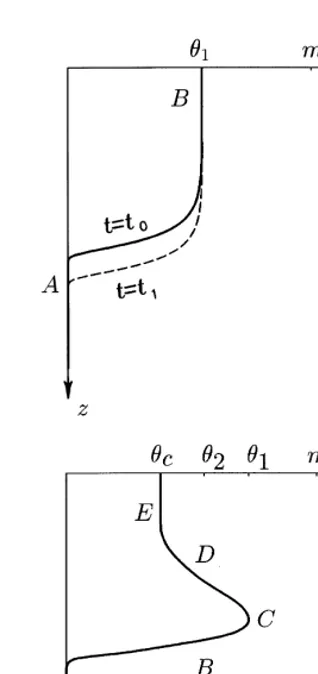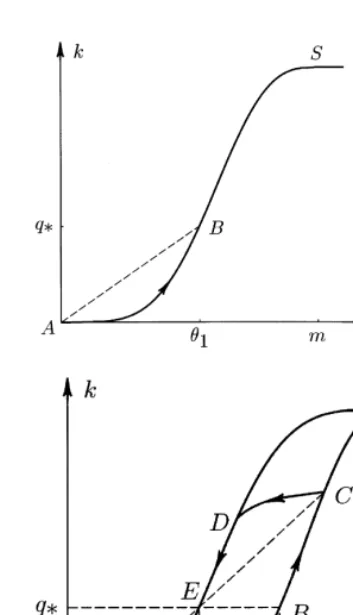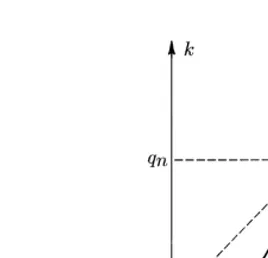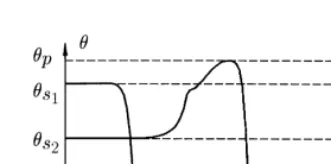Nonmonotonic moisture profile as a solution
of Richards’ equation for soils with
conductivity hysteresis
A.R. Kacimov* & N.D. Yakimov
Kazan University, Institute of Mathematics and Mechanics, University Street 17, 420008 Kazan, Russia
(Received 15 October 1996; accepted 10 July 1997)
Qualitative analysis of similar moisture profiles advancing in dry soils during the constant rate infiltration is proposed. The Richards partial derivative equation is reduced to the ordinary one, which is easily integrated. Using simple kinematic relations nonmonotonic saturation–depth profiles travelling both in 1D case and in 2D finger-type flows are interpreted as a consequence of hysteresis of conductivity depending on water content. The estimations made allow the description of fingering as a result of hysteresis. The mean velocity of hysteretic finger-type flow can be higher than velocity of 1D hysteretic flow while the last advances faster than the usual monotonic front without hysteresis.q1998 Elsevier Science Limited. All rights reserved
Key words: infiltration, fingering, hysteresis, moisture, conductivity.
1 INTRODUCTION
Unsaturated flow in the subsurface, nonuniform in time and space, is of interest in hydrology, soil science, irrigation and drainage practices.8,9,13 Many causes can induce this non-uniformity: matrix heterogeneity, multiphase nature of the flow and varying intensity of external moisture sources, among others. Recent experiments and analysis5,6,11,16 showed that for both 1D and 2,3D cases moisture (capillary pressure) at fixed points within homogeneous layers exhibits pronounced maxima with time. In other words, during constant intensity infiltration along soil surface, tensiometers register in an initially dry matrix, saturation variations of travelling wave type. Intuitively, these water ‘plugs’ can be imagined as punching the ‘conductance’ bar-rier of the dry soil. Fingers or non-trivial flat fronts propa-gating in soils lead to important practical consequences discussed in details5,6,16 (see also the references in these papers).
Numerical procedures based on finite difference and finite element methods treat effectively saturated– unsaturated seepage in heterogeneous soils. However, for preliminary estimations and elucidation of basic
mechanisms governing the flow, simple analytical solutions are still of interest. In this note, we support analytically the idea5,6 that hysteresis is the main mechanism of the time moisture maxima in homogeneous layers exposed to infil-tration. It allows for description of the process in terms of the Richards’ equation involving hysteretic conductivity– moisture curve. In contrast with the traditional assumption on nonhysteretic nature of this curve,10we derive fingering just from this hysteresis mechanism. There is much evi-dence confirming the existence and even the significance of the conductivity–moisture hysteresis.3,4,9,18 For sim-plicity, we do not take into account the ‘main’ hysteresis in suction pressure–moisture. We deem that experiments16 can be explained considering just the conductivity– moisture hysteresis.
We construct a solution of the Richards’ equation that propagates as a ‘rigid’ profile. This solution analysed for a nonhysteretic case3 is an example of the kinematic wave solution and exclusion of a free surface. Note that reduction of the partial differential equation for unsaturated flow to ordinary ones (similar solutions) is a traditional analytical method (see Bear,2pp. 498–500). The assumptions made below, especially about the wetting–drying curves, are very strong and the model used is rather artificial. However, it makes it possible to elucidate qualitative features of the
Printed in Great Britain. All rights reserved 0309-1708/98/$19.00 + 0.00
PII: S 0 3 0 9 - 1 7 0 8 ( 9 7 ) 0 0 0 3 0 - 4
691
advancing nonmonotonous moisture profile for both 1D regimes and finger-type flows.
2 SIMILAR MOISTURE PROFILE
Consider 1D unsaturated flow along the vertical axis Oz (directed downward) in a homogeneous semi-infinite initially dry matrix (Fig. 1). The flow is generated by con-stant flux infiltration of intensity q*. Analogously to Selker
et al.15we assume that the moisture profilev(x), x¼z¹Vt, ¹` ,x, `advances without change of its form, i.e. we
search for a similarity solution to the Richards’ equation. This stabilized, quasi-steady regime appears after a rela-tively short period when wetting is described in terms of transient theories, Horton, Philip, Van Duijn ones, among others (Bear,2pp. 511–515). The profilev(x) travels down-ward with constant velocity V relative to the matrix. Assume
v(`)¼0 andv(¹`)¼v1wherev1corresponds to q*. In
reality, the medium is limited from above by the top bound-ary z¼0 exposed to infiltration. Thus, our first approxima-tion is thatv(¹`) reflects the surface-level conditions. This
seems to be reasonable after the wetting front advances far enough below the soil surface.
The generalized Darcy law states
q¼ ¹k(v)]h
]z (1)
where h is the piezometric head, h ¼w¹z, and wis the pressure normalized to unit weight of water. This equation can be rewritten according to Bear2 (equation 9.4.25, p. 488):
The assumption of similarity gives ] ]t¼ ¹V and, hence, eqn (3) is reduced to
]v
i.e. propagation velocity of the profile equals the mean fluid velocity. Its value can be expressed in terms of the surface infiltration values as
V¼qp=v1 (6)
Substitution of eqn (2) into eqn (3) and integration yields
dx dv¼
k(v)
C(v)[(k(v)¹Vv] (7)
where C¼dv/dw.
All the relations above reproduce, in a slightly different form, the derivations by some of the authors3,15and do not involve any special restrictions on the k(v),w(v) functions. Now, we take into account hysteresis of conductivity assum-ing that C(v) is a positive and nonhysteretic function. Note that pressure–moisture hysteresis can be included easily through C(v). However, we omit this hysteresis to extract the pure effect of conductivity–moisture hysteresis. Usually an opposite assumption is made,10 i.e. k(v) is chosen as a unique function and prehistory is incorporated into w(v). However, there are many confirmations of hysteresis of k(v) functions.3,4,9,18 We include this hysteresis into the Richards’ model to theoretically interpret the experiments.6,16
2.1 Nonhysteretic case
Let’s take k(v) expressed by formulae from the books.2,3 This function is schematically shown in Fig. 2(a) (for sim-plicity irreducible water content is assumed zero). We see that at low v all known k(v) functions are convex with ]k=]v¼0 at v ¼ 0. We assume that our point B (v1, q*)
corresponding to the soil surface lays just on the convex part of the curve k(v) (in practice this curve usually exhibits a concave segment near saturation point S whenv¼m, m is Fig. 1. Physical plane with propagating moisture profiles, t0.t1.
porosity). Point A corresponds to the dry region. Since the segment AB in Fig. 2(a) is convex Vv/k(v). 1 for all
0 ,v, v1. Recall that C(v). 0, hence, we obtain from
eqn (7) that]v/]x,0, i.e. a monotonic profile (Fig. 1(a)).
2.2 Hysteretic case
Consider a loop of the conductivity curve depicted in sketch form in Fig. 2(b). The segment ABCS represents the bound-ary wetting curve, and SDEA is the drying one. To construct a similar regime with a nonmonotonic moisture profile (Fig. 1(b)) the following steps are used:
1. In both hysteretic and nonhysteretic regimes we fix infiltration intensity along the soil surface, i.e. the value of q*. Hence, we draw a horizontal line in Fig. 2(b) through the point (0,q*). This line intersects the boundary drying curve at the point E. This point gives the moisture content near the surface,v2. From
eqn (5) we establish the travel velocity of the corresponding nonmonotonic profile V2¼q¬=v2:
Obviously, V2.V.
2. We draw a straight line AE that intersects the wetting curve at the point C. This point represents maximal saturation vC of the ‘bulb’. From similarity of our solution (factually from conservation of mass) V2¼q*/v¼qC/vC.
3. We draw a primary drying curve CD and hence the whole ‘crook’ ABCDE. Note that in the hysteretic case the points B and D are indicated only for illustrative purposes since they are not used in ‘kinematic’ derivations.
Thus, along AC moisture content increases from 0 tovC
with decrease of z because here dv/dz , 0, while along
the CE moisture content decreases from vC tov2because
dv/dz . 0 along this part of the profile. In other words, hysteresis produces spatial redistribution of moisture: instead of monotonic profile with v1 (nearly everywhere
except for the sharp transition zone near the front), one part of the soil (closer to surface) becomes dryer (v2,v1)
and other part (the ‘bulb’) is wetter. The valuevCjust cor-responds to the maximum value ofwand hence the value of
vobserved in experiments.16
Geometrically, nonmonotonity is caused by the following property: at sufficiently low moisture, boundary wetting– drying curves lay below straight lines passing through the origin of the k–vcoordinate system. Imagine the contrary: let the boundary drying curve be concave near the point A. Then the line AE (see step 2 above) would not intersect the boundary drying curve. Clearly, this simple geometrical analysis of the hysteretic loop can be translated into the more rigorous language of mass balance and similarity assumption (5).
To illustrate nonmonotonic regime we have selected the Brooks–Corey main curves and a parabolic primary wetting curve as
ABC : k1¼
v
m
3
and the primary drying curve as
AED : k2¼b
where k1, k2, k3are nondimensional conductivities
(normal-ized to some reference value kr). As C(v) we take the
func-tion v(m¹v).
Then we integrated eqn (7) as
EDC : x(v)¼xEþ
v*and corresponding point C* in eqn (9) appears because of singularity near the point C where k¼Vv. It leads to two branches of the x(v) curve and one has to practically ‘smooth over’ the singularity near the point C discarding Fig. 2. Conductivity dependencies for (a) nonhysteretic case,
the infinite segments of the solution branches. Mathemati-cally, this situation is very similar to classical hydrody-namics7where some models of free surface flows involve point singularities that locally contradict the physical model even though in the integral sense mathematical models provide good description of the process except for these isolated points.
The results of integration of eqn (9) for example (8) are plotted in Fig. 3 for m¼0.5, v2¼ 0.1m, b¼2, xE¼0. Numerical integration was performed with a small step «
and singularity was isolated by choosing v* ¼ vC ¹ 2«. Obviously, this example does not model any practical soil and only tests the integration technique.
3 DISCUSSION AND CONCLUSION
Many hydrological applications follow from the experi-ments and analysis of nonuniform wetting.5,6,16We would add only one point following from the existence of hystere-tic fronts: namely, the routine measurements of 1D artificial steady infiltration should be used with care for prediction of evaporation flows since in hysteretic soils these regimes are essentially different.
Note that under assumptions made, a maximal value of profile velocity exists. Namely, if the wetting curve exhibits an inflection point I (Fig. 4) the maximum velocity corre-sponds the point M where the ‘steepest’ (i.e. of maximum angle arctan(v2/q*)) straight line AE (see step 1 in the
pre-vious section) is tangential to the primary wetting curve:
Vn¼ k(vmax)
vmax
¼qn
vn
It seems reasonable that steady 1D regimes of nonmono-tonic advancing profiles16 with q* . qn are impossible. Nevertheless, the mean velocity of fluid movement in soil can be higher than V2! This is possible if we pass from 1D
profiles to a 2D regime.5,6,15Let us model fingers as cylin-ders with core moisturevn, flux qn, and mean pore velocity
Vn. Capillary pressure in any horizontal section is constant, which is necessary for the existence of steady fingers. In the following qualitative explanations we take into account hysteresis in w(v) (see Glass et al.,6Fig. 2). Then within the interfinger dry zones, moisture vd and qd are much
lower than in the finger core zone (Fig. 4). Designate the areal ratio of fingered, highly conductive zones as s, 0,s,1. So we can express the mean flux qathrough the
porous matrix:
qa¼qnsþqd(1¹s)¼qp
The mean velocity of moisture movement will be
Va¼ q
2
ns
vmqpþ
q2d(1¹s)
vdqp
Obviously, Va,Vn. Depending on the hysteresis loop the regimes with Va. V2are possible. Thus, finger-type flow
advances faster than a nonmonotonic 1D profile. In turn, the velocity of a nonmonotonic 1D flow is higher than for the usual 1D monotonic profile.
The flow picture is shown in Fig. 5 and coincides with the scheme investigated.5,6In terms of our model we can inter-pret the results5,6that vm < m, as a confirmation that the concave segment of the drying curve is small if any.
We can suggest the following qualitative explanation of appearance of the persistent finger-type flow pattern in Fig. 5. First, the usual monotonic profile disperses near the front. Then, the nonmonotonic regime appears because Fig. 3. Calculated nonmonotonic conductivity profile.
Fig. 4. Hysteretic loops showing maximal value of moisture movement, low and high permeability values for finger type flow.
of longitudinal instability. If q*,qn(and hence the finger-type regime is possible), then the nonmonotonic 1D regime becomes potentially unstable due to transverse (Taylor–Saffman-like) spatial instability. Small moisture ‘bulges’ become more conductive and ‘sink’ the fluid from the lagging zones of lower water content. Within the developed cylindrical fingers in Fig. 5, the distribution ofv
in the vertical direction is like in Fig. 1(b), increasing from
vntovmax(Fig. 4) near the tip and then decreasing to zero. In
the dry zonevdecreases fromvdto zero, as in Fig. 1(a). The model presented can be extended to a non-zero matrix initial moisture,1 redistribution regime, step-wise changing infiltration intensity with multi-maxima profiles,16 two-layer soils, and hysteretic C(v) curves. However, before these generalizations, a micro-level model should be devel-oped similar to Tamai et al.17This percolation-type struc-tural model14 involves fluid flow in a hierarchy of ‘ink bottle’ type capillaries of nonuniform radii. The matrix is modeled as a set of ‘sites’ that represent a finite difference approximation to the Richards’ equation, and ‘bonds’ com-posed of the capillary bundles mentioned. Even though detailed results of micro-level modeling are out of the scope of this report we would like to present one example. So Fig. 6 shows the advancing monotonic profile in a net-work of 1D capillaries (curve 1) with stabilized moisturevs1. Then infiltration intensity was distributed in a pulse mode with a peak value ofvp. When infiltration intensity returned to the non-disturbed value, the surface moisturevs2occurred
lower than in the monotonic regime and a solitary wave (curve 2) travelled downward (obviously, with a higher velocity than in the monotonic case). Many intriguing phenomena (non-Lyapunov stability, disturbance dissipation, influence of dimensionality of the network and the form of hysteretic loops in k(v) curves, etc.) were found here and confirmed quantitatively the qualitative analysis above.
One-dimensional nonmonotonic profiles, fingering as well as preferential channeling in fractured rocks, can be viewed as quasi-stable dissipative patterns appearing in nonlinear systems under special conditions.12An important problem concerns not only standard temporal and spatial description of these patterns but determination of the inte-gral characteristics (functionals) that become minimum or maximum at real regimes. Qualitatively, one may expect that water exposed at the soil surface ‘tends’ to seep down-wards ‘as easy (or as fast) as possible’. In this sense the
Stonestrom and Akstin16regime is preferable as compared with the standard monotonic infiltration, while the 2D pattern6is ‘better’ than 1D.16 Namely, after some time T (sufficient enough for validity of our 1D similar solutions) the cumulative infiltration in both cases of monotonic and nonmonotonic 1D moisture profiles is the same, q*T. How-ever, in the case of the Stonestrom and Akstin regime,16the velocity V of profile evolution is faster and because of the ‘bulb’ of higher saturation the center of mass of the water body seeped is located at a lower level. Variational state-ments for unsaturated flows will complement the known technique of error minimization in finite element methods.
ACKNOWLEDGEMENTS
This study was supported by the International Science Foundation–Russian Government, joint grant NJ72100, and Russian Foundation of Basic Research, grants N 95-01-00448, 96-0100844-a. The authors appreciate helpful comments made by V. M. Mironenko and three anonymous reviewers.
REFERENCES
1. Babel, M. S., Das Gupta, A. and Loof, R. Simulation of stable and unstable flows in unsaturated homogeneous coarse sand. Hydrological Sciences J., 1997, 42, 49–65. 2. Bear, J., Dynamics of Fluids in Porous Media. Elsevier, New
York, 1972.
3. Childs, E. G., Soil Water Phenomena. Whiley Interscience, London, 1969.
4. Collis-George, N. and Rosenthal, M. J. Proposed outflow method for the determination of the hydraulic conductivity of unsaturated porous material. Australian J. Soil Research, 1966, 4, 165–180.
5. Glass, R. J., Parlange, J.-Y. and Steenhuis, T. S. Wetting front instability 1. Theoretical discussion and dimensional analysis. Water Resour. Res., 1989, 25, 1187–1194. 6. Glass, R. J., Steenhuis, T. S. and Parlange, J.-Y. Mechanism
for finger persistence in homogeneous, unsaturated, porous media: theory and verification. Soil Sci., 1989, 148, 60–70. 7. Gurevich, M. I., Theory of Jets in an Ideal Fluid. Academic
Press, New York, 1965.
8. Hillel, D., Introduction to Soil Physics. Academic Press, San Diego, 1982.
9. Iwata, S., and Tabuchi, T., Soil Water Interactions: Mechan-isms and Applications. Dekker, New York, 1988.
10. Janes, A. T., Soil water hysteresis: mdels and implications, In Process Studies in Hillslope Hydrology, ed. M. G. Anderson and T. P. Burt. Wiley, Chichester, 1990, pp. 93–126. 11. Lu, T. X., Biggar, J. W. and Nielsen, D. R. Water movement
in glass bead porous media 2. Experiments of infiltration and finger flow. Water Resour. Res., 1994, 30, 3283–3290. 12. Murray, J. D., Lectures on Nonlinear Differential Equation
Models in Biology. Clarendon Press, Oxford, 1977. 13. Neuman, S. P. and Chen, G. On instability during immiscible
displacement in fractures and porous media. Water Resour. Res., 1996, 32, 1891–1894.
14. Romm, E. S., Structural Models of the Pore Space of Rocks. Nedra, Leningrad, 1985 (in Russian).
Fig. 6. Computations based on a micro-level model, curve 1 and 2 represent the usual monotonic profile and a ‘faster’ profile with a
15. Selker, J., Parlange, J.-Y. and Steenhuis, T. Fingered flow in two dimensions 2. Predicting finger moisture profile. Water Resour. Res., 1992, 28, 2523–2528.
16. Stonestrom, D. A. and Akstin, K. C. Nonmonotonic matric pressure histories during constant flux infiltration into homogeneous profiles. Water Resour. Res., 1994, 30, 81–91.
17. Tamai, N., Asaeda, T. A. and Jeevaraj, C. G. Fingering in two-dimensional, homogeneous, unsaturated porous media. Soil Sci., 1987, 144, 107–112.



